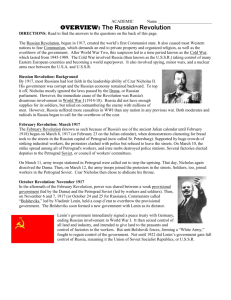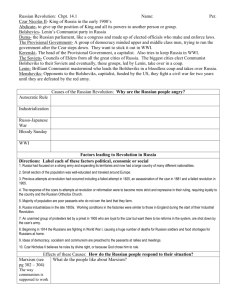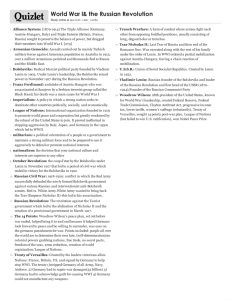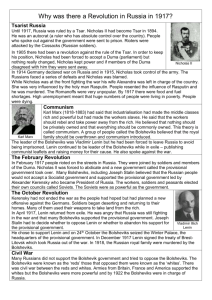Chapter 12 Section 3: Revolution in Russia
advertisement
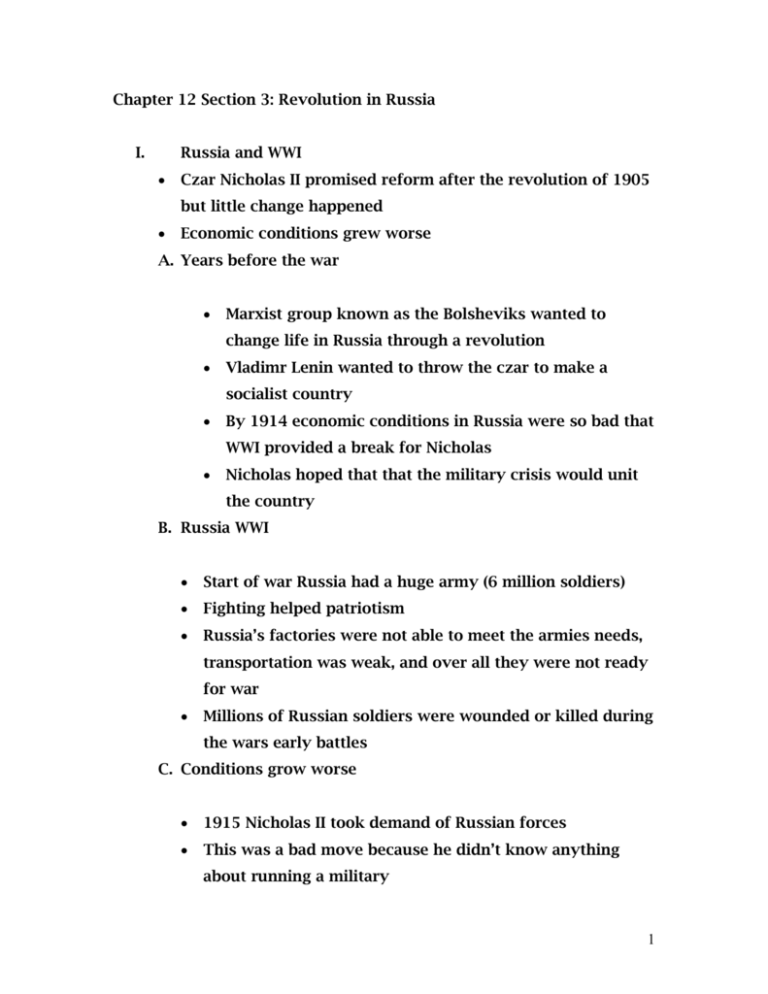
Chapter 12 Section 3: Revolution in Russia I. Russia and WWI Czar Nicholas II promised reform after the revolution of 1905 but little change happened Economic conditions grew worse A. Years before the war Marxist group known as the Bolsheviks wanted to change life in Russia through a revolution Vladimr Lenin wanted to throw the czar to make a socialist country By 1914 economic conditions in Russia were so bad that WWI provided a break for Nicholas Nicholas hoped that that the military crisis would unit the country B. Russia WWI Start of war Russia had a huge army (6 million soldiers) Fighting helped patriotism Russia’s factories were not able to meet the armies needs, transportation was weak, and over all they were not ready for war Millions of Russian soldiers were wounded or killed during the wars early battles C. Conditions grow worse 1915 Nicholas II took demand of Russian forces This was a bad move because he didn’t know anything about running a military 1 Central powers were able to stop a major Russian offense Confidence was destroyed Russian peasants grew desperate because of the lack of food and goods Czarina Alexandra (czars wife) was in control but she was very unpopular She relied on a healer and self proclaimed healer but was corrupt and was not good which made everything worse II. The Russian Revolution A. Revolution Begins March 8, 1917 unhappy citizens marched the streets of Petrograd (the capital of Russia) to protest the lack of food and fuel Soldiers were ordered to shoot rioters but they did not they ended up joining them and took over the monarchy The March Revolution forced Nicholas to step down is known as the February Revolution in Russia B. Provisional Government After the fall of the czar Duma created a temporary government Government was led by Aleksandr Kerensky Planned to continue fighting in WWI even though unhappy with the new leadership 2 The temporary government was called the Bolsheviks a Marxist Revolution They planned to abolish (get rid of) private property and enforce social equality Bolshevism became known as Marxism-Leninism after Vladimir Lennin C. The Bolshevik Revolution In mid 1917 Kerensky’s government ordered a final fight against the Central Powers along the Eastern Front It failed Officers were being killed by their own men in Russia The army collapsed November 1917 armed Bolshevik factory workers known as the Red Guard attacked the temporary government (known as October Revolution) Lenin became the nations leader and created a radical Communist Movement Bolsheviks gave land to the peasants and seized Russia’s factories III. After the Revolution A. Civil War Lenin sent Leon Trotsky, a top Bolshevik official to negotiate peace with the Central Powers and get Russia out of WW1 The peace treaty insulted the Russians and those that opposed created the White Army The White Army opposed Lenin’s Communist system 3 The Whites received help from France and the United States B. New Economic Policy Civil war pushed Russia’s collapsing economy to the end Lenin responded to the crisis in 1921 which involved capitalist activity Peasants could sell there food for profit Food production then increased C. The Soviet Union 1922 the Russian economy began to improve United with several neighboring lands before 1917 The new country was called the Union of Soviet Socialist Republic also known as the Soviet Union Russia’s communist leadership took over the entire country Lenin died in 1924 4






